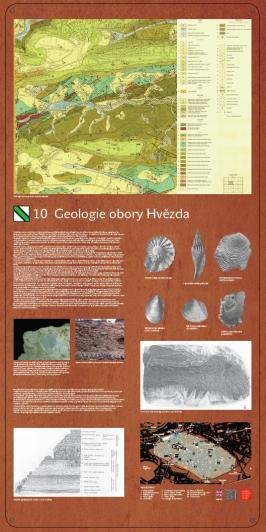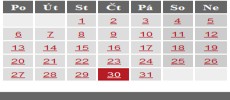(![]() Geologie Obory Hvězda - informace v českém jazyce)
Geologie Obory Hvězda - informace v českém jazyce)
Although the game-preserve by the Hvězda pleasure house was declared as a specially protected area mostly for the silvicultural and botanical aspects, there are places of natural and artificial outcrops of cretaceous minerals. Most outcrops are located in the southern and western parts of the game-preserve, close to the wall. In this part of the game-preserve, they are mostly formed by Cenomanian minerals, sandstone dating back approximately 100 million years.
In the lower part, there are fox-yellow or yellow-grey, coarse-grained, kaolinite sandstones of Peruc layers. They contain a strong admixture of rusty hydrous ferric oxide – limonite, and their marked crossed stratification demonstrates their origin in a stirring environment nearby the sea shore. These sandstones are home to the so-called aquifer – water horizon used as a water reservoir during the construction of the Prague Castle water conduit during the reign of Rudolph II.
The overburden contains typical sea sediments of Korycany layers. The lower coarse-grained sandstones are covered with yellow-grey, medium-grained sandstones, which already had its origin in the sea environment, although the sea shore at the time was not too far away. There are traces of crawling in the sandstone, together with small lairs of sea organisms, probably clam, the undeterminable remains of which can also be found in the sandstone.
The third layer to be found in this area is represented by greenish to dark green, medium to fine-grained sandstone with glauconite. It is glauconite, a silicate-class mineral with bivalent iron of a green-grey colour, what gives the sandstone its green colour. There are numerous traces of crawling clam in the sandstone, with their fossils also quite frequently found, especially Protocardia hillana (SOWERBY), Lopha diluviana (LAMARCK) a Rhynchostreon suborbiculatum (LAMARCK).
Above this layer, we can encounter fragments of marl from the youngest layer, Bílá Hora layer, which is well revealed in the former quarry nearby the actual pleasure house in the game-preserve. These were revealed nearby a small quarry next to the pleasure house. The marl of the Bílá Hora layer was used as the building stone in medieval Prague.
Today, the small quarry is quite overgrown and it was not established here by coincidence. In the past, it was used for breaking marl belonging to the fourth layer in our profile, used as perfect building stone, which was used to build a major part of medieval Prague, and also during the construction of the Hvězda pleasure house. It is still mined in some localities near Prague and Rakovník, but it is mostly used for repairing medieval cultural heritage.
Marl is an established term for arenaceous marlites with rich admixture of silica (especially in the form of chalcedony or opal, less frequently of quartz), which mostly formed the skeletons of animal sea fungi (Porifera). Marl is whitish or yellow and small cubes are made of them during the mining, which are then used in building as masonry material.
The local marl belongs to the Bílá Hora layer of Bohemian Cretaceous Period, being approximately 90 million years old. During the sedimentation of marl in the Bílá Hora layers, the Bohemian Cretaceous Sea was deepened and extended. Marl deposited further away from the shore and spread significantly in the Bohemian region. These sediments are fine-grained with strong dust admixture, which makes them firm, resisting bad weather for hundreds of years. Marl was exploited as building stone not only at Hvězda, but also at Strahov, Břevnov and around Bílá Hora. Today, nearly all quarries and small marl quarries are filled up, and the small, partially overgrown quarry near Hvězda has become a precious rarity.
Numerous fossils were found in the marl, documenting past life in the sea. There are significant species of clam, specifically Mytiloides labiatus (SCHLOTHEIM) and Mytiloides hercynicus (PETRASCHEK), other species of clam: Lima aspera (MANTELL), Spondylus spinosus (SOWERBY) or Exogyra lateralis (REUSS), snails: Leptomaria seriatogranulata (GOLDFUSS), Turritella multistriata (REUSS) or Rostellaria reussi (GEINITZ), cephalopods ammonites like Mammites nodosoides (SCHLOTHEIM) or Collignoniceras woollgari (MANTELL). Besides those, remains of crayfish or fish were found, as well as shark teeth or even parts of jaws, and also vertebra of plesiosaur, a sea reptile.
In the past, marl was exploited manually, making it easier to discover the fossils. Studying the fossils brought about good level of knowledge regarding the Bohemian Cretaceous Sea, and many of the local fossils are exhibited in the Prague National Museum, having been acquired by Antonín Frič, a palaeontology professor and a keeper of the palaeontology collections in the National Museum. He was the first to set up the first ideal profile through the Bílá Hora and Malnice layers according to the findings acquired during research at Bílá Hora, by Dřínov and Vehlovice. The Bílá Hora layers make up layers 2 to 9 at the profile; higher layers belong to the transitional positions to the Jizera layers.
Nature trail "Oborou Hvězda":
- The History of the Game-Preserve
- Old Oak Growths
- Hvězda and its Surroundings
- Birds in the Game-Preserve
- The Pleasure House
- Personalities in the History of Hvězda
- Natura 2000 and wetland
- Beech-Wood under the Pleasure House
- Water in the Game-Preserve
- The Geology of Hvězda Game-Preserve (Geologie Obory Hvězda - informace v českém jazyce)
- The Battle of Bílá Hora
- Hvězda Game-Preserve and Hunting
- Animals in the Game-Preserve
- Forest Renewal





